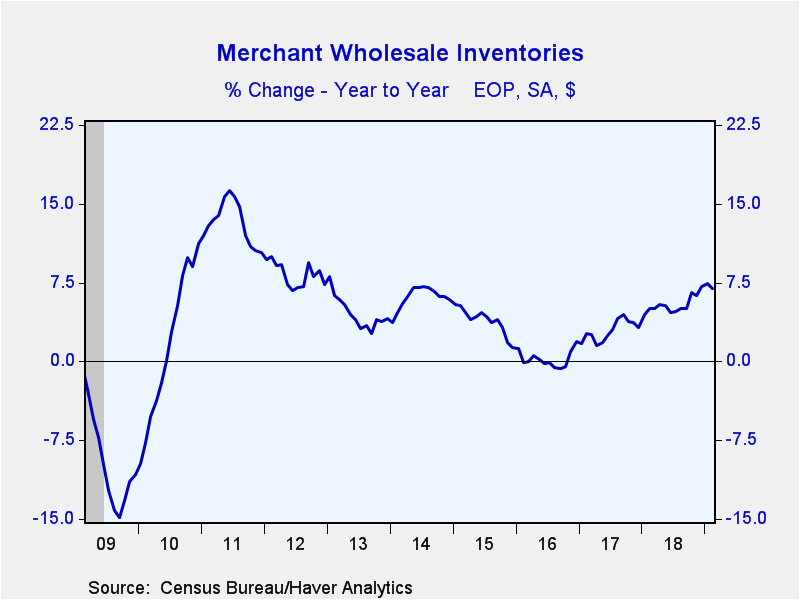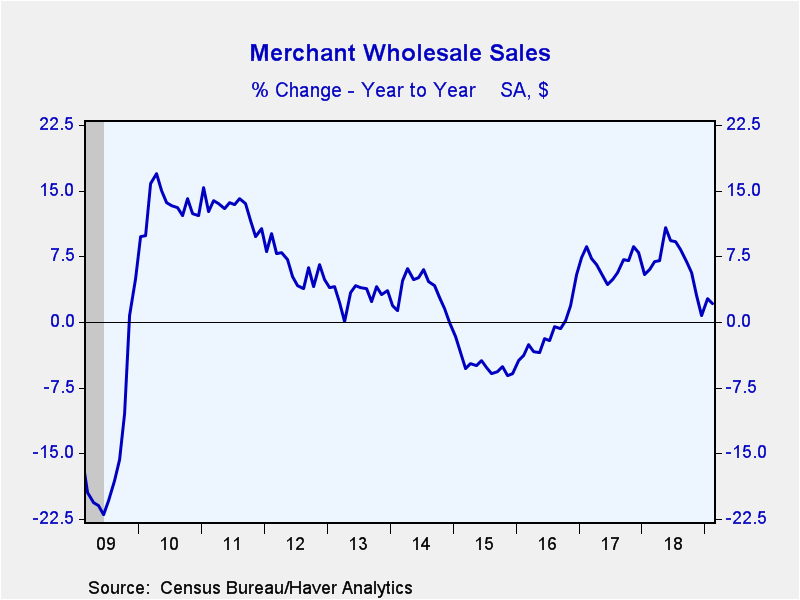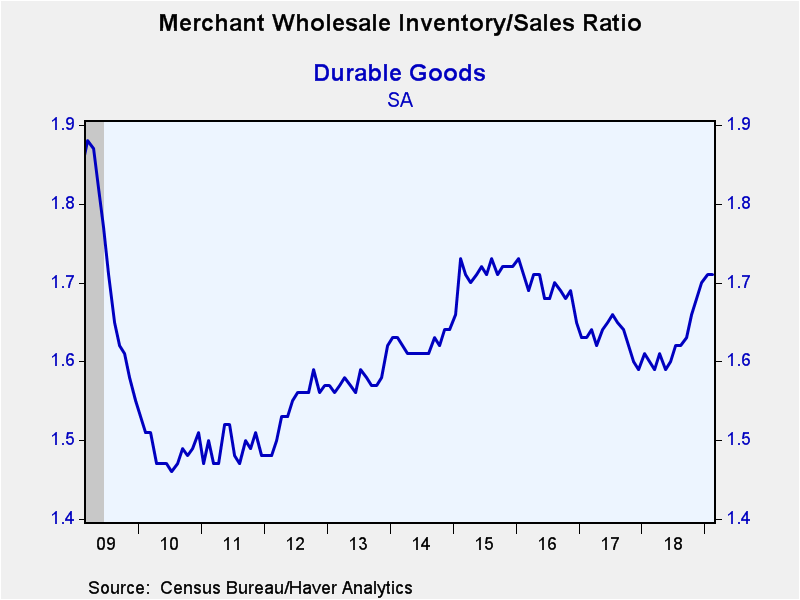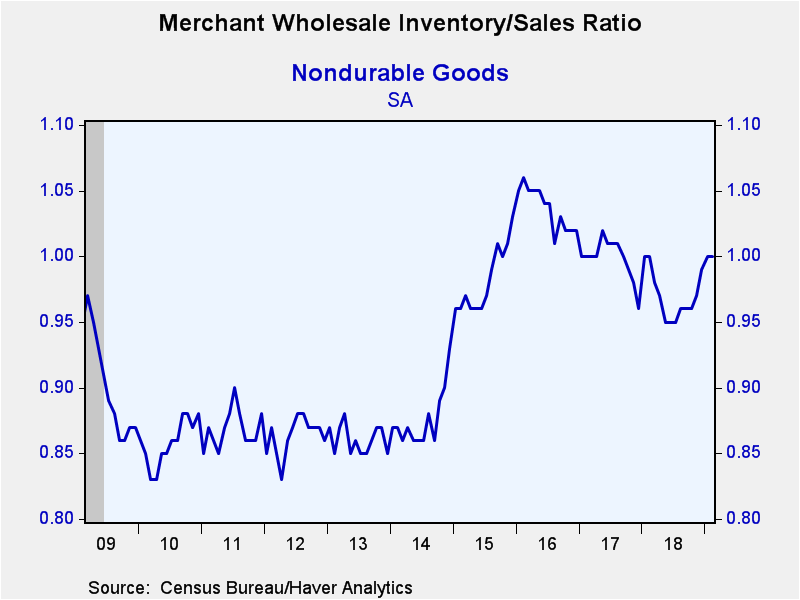 Global| Apr 17 2019
Global| Apr 17 2019U.S. Wholesale Inventories and Sales Continue to Rise
by:Tom Moeller
|in:Economy in Brief
Summary
Wholesale inventories increased 0.2% (6.9% y/y) during February following a 1.2% gain in January. The Informa Global Markets Survey expected a 0.5% rise. Durable goods inventories increased 0.1% (10.6% y/y) after a 0.8% gain. [...]
Wholesale inventories increased 0.2% (6.9% y/y) during February following a 1.2% gain in January. The Informa Global Markets Survey expected a 0.5% rise.
Durable goods inventories increased 0.1% (10.6% y/y) after a 0.8% gain. Machinery inventories, the largest sector, grew 0.7% (12.6% y/y), while motor vehicle inventories nudged 0.1% higher (9.4% y/y). Electrical equipment inventories also rose 0.1% (10.6% y/y). Inventories of nondurable goods gained 0.3% (1.4% y/y) after rising 1.8% in January. Drug inventories, which make up a quarter of nondurable inventories, rose 1.7% (1.0% y/y). Groceries, the second largest category, gained 0.3% (1.0% y/y). Apparel inventories increased 1.8% (10.1% y/y) but petroleum inventories fell 1.3% (-7.2% y/y).
Wholesale sales grew 0.3% during February (2.1% y/y) after a 0.5% increase. The increase matched expectations in the Action Economics Forecast Survey.
Durable goods sales rose 0.1% (3.2% y/y) after a 0.2% increase. Electrical equipment sales, the largest sector, rebounded 1.5% (3.5% y/y) following a sharp January decline. Professional and commercial equipment, which includes computers, rose 0.6% (3.0% y/y). Vehicle sales improved 0.3% (2.2% y/y). Nondurable product sales rose 0.4% (1.1% y/y) after a 0.9% rise. Petroleum product sales increased 2.9% (-0.6% y/y). Drug purchases grew 0.2% (6.7% y/y) and apparel sales rose 1.4% (-2.0% y/y). Chemical sales jumped 2.7% (2.4% y/y) after three months of sharp decline.
The inventory-to-sales (I/S) ratio held steady at 1.35, but recently has been trending higher. The I/S ratio for durable goods was unchanged at 1.71, the highest level since early-2016. The machinery ratio surged to 2.69 but motor vehicles eased to 1.72. The I/S ratio for nondurable goods held steady at 1.0. The petroleum industry I/S ratio slipped to 0.37. The apparel industry I/S ratio held at the expansion high of 2.23, but the chemical industry ratio slipped to 1.12.
The wholesale trade figures and oil prices are available in Haver's USECON database. The expectations figure for inventories is contained in the MMSAMER database. Expectations for sales are in the AS1REPNA database.
| Wholesale Sector - NAICS Classification (%) | Feb | Jan | Dec | Feb Y/Y | 2018 | 2017 | 2016 |
|---|---|---|---|---|---|---|---|
| Inventories | 0.2 | 1.2 | 1.1 | 6.9 | 7.1 | 3.3 | 1.9 |
| Sales | 0.3 | 0.5 | -0.7 | 2.1 | 6.6 | 6.7 | -1.3 |
| I/S Ratio | 1.35 | 1.35 | 1.34 | 1.29 (Feb '18) | 1.28 | 1.29 | 1.35 |
Tom Moeller
AuthorMore in Author Profile »Prior to joining Haver Analytics in 2000, Mr. Moeller worked as the Economist at Chancellor Capital Management from 1985 to 1999. There, he developed comprehensive economic forecasts and interpreted economic data for equity and fixed income portfolio managers. Also at Chancellor, Mr. Moeller worked as an equity analyst and was responsible for researching and rating companies in the economically sensitive automobile and housing industries for investment in Chancellor’s equity portfolio. Prior to joining Chancellor, Mr. Moeller was an Economist at Citibank from 1979 to 1984. He also analyzed pricing behavior in the metals industry for the Council on Wage and Price Stability in Washington, D.C. In 1999, Mr. Moeller received the award for most accurate forecast from the Forecasters' Club of New York. From 1990 to 1992 he was President of the New York Association for Business Economists. Mr. Moeller earned an M.B.A. in Finance from Fordham University, where he graduated in 1987. He holds a Bachelor of Arts in Economics from George Washington University.










